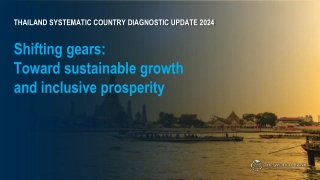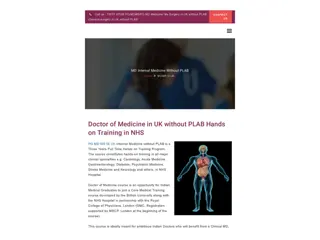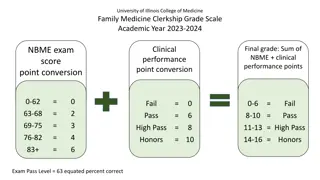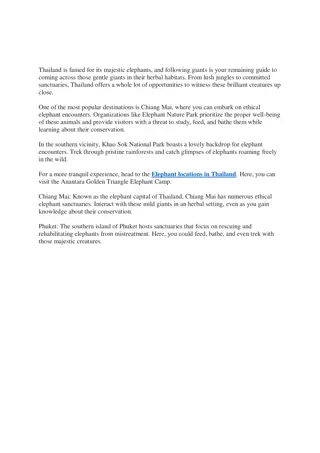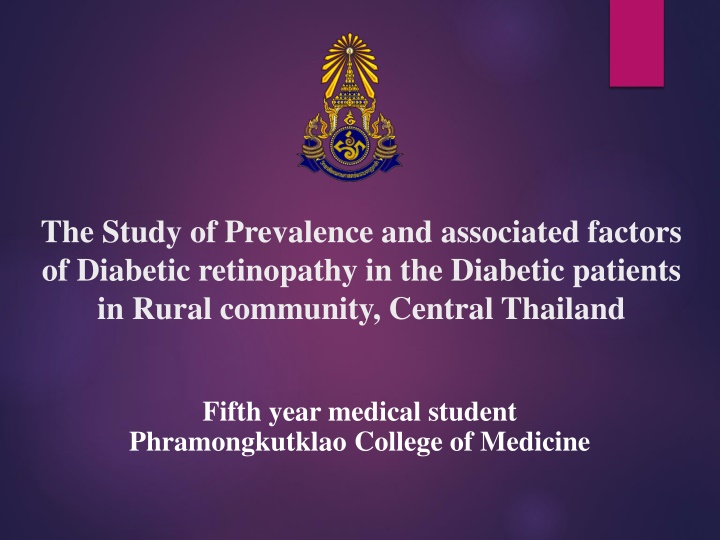
Prevalence and Factors of Diabetic Retinopathy in Rural Central Thailand
Investigating the prevalence and associated factors of diabetic retinopathy in diabetic patients in a rural community in central Thailand. The study delves into the background of diabetes mellitus, cataract, and other eye conditions prevalent in Thailand. It aims to determine the prevalence of diabetic retinopathy and identify associated factors through a quantitative cross-sectional study. Research variables include biological factors, individual factors, and early detection methods.
Download Presentation

Please find below an Image/Link to download the presentation.
The content on the website is provided AS IS for your information and personal use only. It may not be sold, licensed, or shared on other websites without obtaining consent from the author. If you encounter any issues during the download, it is possible that the publisher has removed the file from their server.
You are allowed to download the files provided on this website for personal or commercial use, subject to the condition that they are used lawfully. All files are the property of their respective owners.
The content on the website is provided AS IS for your information and personal use only. It may not be sold, licensed, or shared on other websites without obtaining consent from the author.
E N D
Presentation Transcript
The Study of Prevalence and associated factors of Diabetic retinopathy in the Diabetic patients in Rural community, Central Thailand Fifth year medical student Phramongkutklao College of Medicine
Background Diabetes mellitus International Diabetes Federation. The IDF Diabetes Atlas, 2014
Background Cataract Diabetic retinopathy 13.6 31.4% Glaucoma Retinal detachment Visual impairment Blindness Diabetes mellitus in Thailand 6.3 million Chaicharn Deerochanawong. Diabetes management in Thailand; a literature review of the burden, costs, and outcomes. 2013 International Diabetes Federation. The IDF Diabetes Atlas, 2014
Background Initial dilated and comprehensive eye examination by an ophthalmologist or optometrist Patients with type 1 diabetes : within 5 yearsafter diabetes onset Patientswithtype 2 diabetes : shortlyafterdiagnosis If no retinopathy for 1 eye exam : consider re-examinate every 2 years If retinopathy : annual exam Retinopathy progressing or sight threatening : more frequent exams 2015 American Diabetes Association (ADA) Diabetes Guidelines
Background 67.7 % Diabetic patients Hospital - based Community based? An Assessment on Quality of Care among Patients Diagnosed with Type 2 Diabetes and Hypertension Visiting Hospitals of Ministry of Public Health and Bangkok Metropolitan Administration in Thailand, 2012
Objective To determine prevalence of Diabetic retinopathy among diabetic patients in Rural area, central Thailand To determine associated factor of Diabetic retinopathy among diabetic patients in Rural area, central Thailand
Materials and Methods : Study method Quantitative study Cross-sectional study Prevalence Associated factor
Materials and Methods : Study method Research variable Associated factor Diabetic retinopathy Biological factors Type of Diabetes Mellitus Duration of disease Diabetic status Underlying disease BMI Waist circumference Individual factors Sex, Age Religion Marital status Education Occupation Early detection Serum creatinine Microalbuminuria Blood pressure HbA1C level
Materials and Methods : Study Population Quantitative study Diabetic patients in rural community, Thailand Inclusion criteria Diabetic patients in Takradan district, Sanam Chai Khet district, Chachoengsao Province Patients who are willing to join this research recruitment and had given consents Target population Study population
Materials and Methods : Study Population Quantitative study Diabetic patients in rural community, Thailand Exclusion criteria Disability/ Death/ Moved Diabetic patients who were not able to give researched samples, i.e., blood and urine during certain time Targetpopulation Study population
Materials and Methods Study procedure Informed consent Diabetic patients Determine prevalence Determine associated factor Physical examination Investigation : Blood, Urine Questionnaire Fundus photography Descriptive Analytic Statistic analysis Prevalence Associated factor
Tools and Data collection Demographic data Questionnaire Prevalence of DR Fundus photography Diagnosed by Ophthalmologists Associated factors Questionnaire Physical Examination, Lab investigation
Ethical consideration Reviewed and approved by the Institutional Review Board (IRB) of the Royal Thai Army Medical Department
Result Table 1 : Demographic data of Diabetic patients N =172 (%) Gender Male 57 33.1 Female 115 66.9 Age (years) < 50 34 19.8 50 59 46 26.7 60 69 58 33.7 70 34 19.8 Mean SD(Min-Max) 60.0 12.0(21-97)
Result Table 1 : Demographic data of Diabetic patients N =172 (%) Status Married Widow/divorced/separated Single Education Non-literated Primary school Higher than primary school Occupation No occupation Farmer Other 138 29 5 80.2 16.9 2.9 18 144 10 10.5 83.7 5.8 48 103 21 27.9 59.9 12.2
Result Table 1 : Demographic data of Diabetic patients N =172 (%) Income per month (Baht) No income 41 23.8 < 5,000 87 50.6 5,000 44 25.6 Scheme Universal health coverage 155 90.1 Other 17 9.9
Result Table 1 : Demographic data of Diabetic patients N =172 (%) Smoking Non-smoking 119 69.2 Smoked 29 16.9 Smoking 24 14 Alcohol Non-alcohol drinking 108 62.8 Quit drinking 33 19.2 Alcohol drinking 31 18
Result Table 2 : Biological factors in Diabetic patients N =172 (%) Duration of Diabetes (years) Median (Min-Max) On Diabetic treatment 6(0-30) No 30 17.4 Yes 142 82.6 Metformin usage Not use 68 40.5 Use 100 59.5
Result Table 2 : Biological factors in Diabetic patients N =172 (%) Family history of Diabetic retinopathy No Yes Underlying of Kidney disease No Yes Underlying of Dyslipidemia No Yes Underlying of Hypertension No Yes 151 9 94.4 5.6 140 18 81.4 10.5 68 92 39.5 53.5 68 101 39.5 58.7
Result Table 2 : Biological factors in Diabetic patients N =172 (%) Frequency of exercise per week < 3 days or no exercise 117 68.8 3 days 53 31.2 BMI (kg/m2)* Underweight (<18.5) 6 3.5 Normal weight (18.5 22.9) 78 45.3 Overweight (23.0 24.9) 59 34.3 Obese ( 25) 29 16.9 * WHO expert consultation. Appropriate body-mass index for Asian populations and its implications for policy and intervention strategies. The Lancet, 2004; 157-163.
Result Table 2 : Biological factors in Diabetic patients N =172 (%) Waist Circumference (cm)* Male < 90, Female < 80 Male 90, Female 80 HbA1C (%) Well controlled (<7%) Poor controlled ( 7%) 55 117 32 68 71 101 41.3 58.7 * Misra A .Waist circumference cutoff points and action levels for Asian Indians for identification of abdominal obesity. Int J Obes (Lond). 2006 Jan;30(1):106-11.
Result Table 2 : Biological factors in Diabetic patients N =172 (%) GFR (min/mL/1.73 m2) CKD stage I (GFR 90) 39 22.7 CKD stage II (GFR 60 89) 57 33.1 CKD stage III (GFR 30 59) 57 33.1 CKD stage IV (GFR 15 29) 14 8.1 CKD stage V (GFR < 15) 5 2.9
Result Table 3 : Univariate and multivariate analysis for diabetic retinopathy DR n(%) Non DR n(%) Crude Odds ratio 95%CI p-value Adjusted 95%CI Odds ratio p-value Gender Male Female Age (years) < 60 60 11(20.4) 43(79.6) 18(16.4) 92(83.6) 1.31 1 0.57-3.01 0.528 1.77 1 0.70-4.49 0.227 20(25.6) 58(74.4) 9(10.5) 2.95 1 1.25-6.95 0.013 3.01 1 1.17-7.73 0.022 77(89.5)
Result Table 3 : Univariate and multivariate analysis for diabetic retinopathy DR n(%) Non DR n(%) Crude Odds ratio 95%CI p-value Adjusted 95%CI Odds ratio p-value On diabetic medication No Yes Family history of diabetes retinopathy No 26(18.2) Yes 2(22.2) Underlying of kidney disease No 11(16.9) Yes 18(18.8) 2(6.7) 27(20.1) 28(93.3) 107(79.9) 0.28 1 0.06-1.26 0.098 0.38 1 0.08-1.78 0.222 117(81.8) 7(77.8) 1 1 1.29 0.25-6.55 0.762 1.11 0.19-6.54 0.905 54(83.1) 78(81.3) 1 1 4.75 1.56-14.5 0.006 4.04 1.23-13.21 0.021
Result Total population was 245 people Prevalence of Diabetic retinopathy among diabetic patient 37 diabetic patients has diabetic retinopathy (15.1 %) Only 2 patients already got into the universal health coverage system
Compare result with previous study Hospital-based Studies * 13.6 31.4 Community-based study 15.1 Prevalence (%) Associated Factors Duration HbA1c Age Underlying of kidney disease High Blood pressure * JongsareejitA. The Thai DMS Diabetes Complications (DD.Comp.) project; prevalence and risk factors of diabetic retinopathy in Thai patients with Type 2 Diabetic mellitus. 2013 Chaicharn Deerochanawong. Diabetes management in Thailand; a literature review of the burden, costs, and outcomes. 2013
Discussion Among 37 patients with diabetic retinopathy, only 2 patients already got into the universal health coverage system Only 1 eye examination per year in this community About 30 patients get their eye examinations per year
Discussion Lack of ophthalmologist and fundus photography in rural communities Underestimated prevalence due to unmovable fundus photography
Conclusion Prevalence 15.1% (37 patients) Only 2 patients got into the universal health coverage system due to inadequate health care supplies; ophthalmologist and fundus photography Associated factors: Age <60 years old Underlying of kidney disease
Limitation Unable to move fundus camera Cataract had concealed fundus examination
Recommendation As there is only 1 eye examination for the community per year and it is rare to get an ophthalmologist to do an eye examination in such rural community, health care providers should encourage patients to control their disease and prevent them from getting severe complications.
Intervention Mild & Moderate NPDR Arrange Follow-up DR screening Encourage Diabetic control Refer to Sanamchaikhet Hospital Severe NPDR & PDR Require treatment
Acknowledgement 1. Department of Military and Community medicine, Phramongkutklao College of Medicine 2. Department of Ophthalmology, Phramongkutklao College of Medicine 3. Office of Research Development, Phramongkutklao College of Medicine

